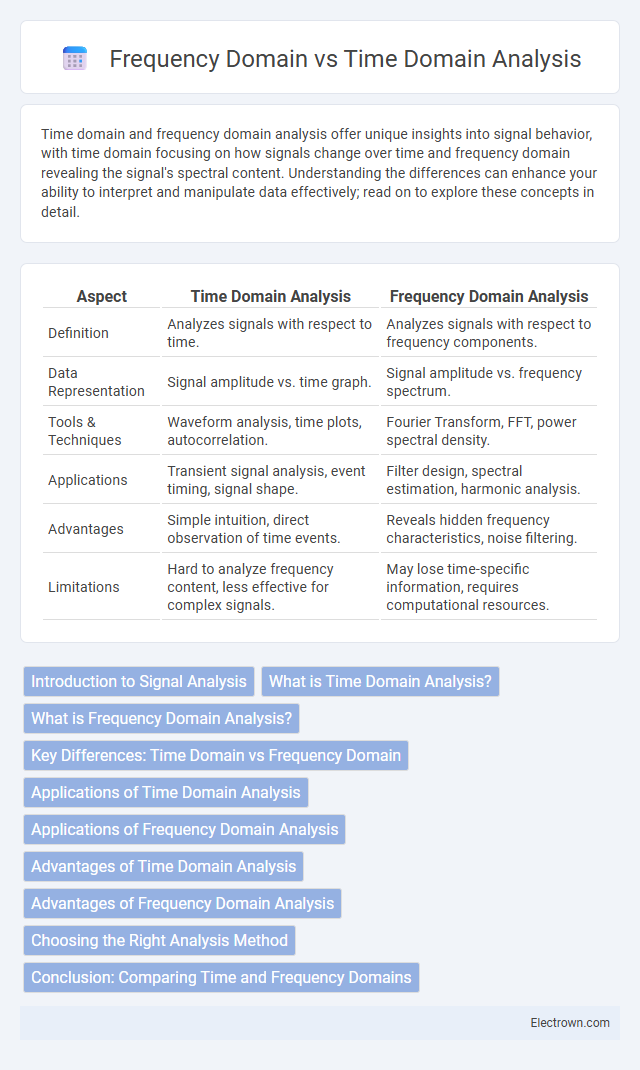Time domain and frequency domain analysis offer unique insights into signal behavior, with time domain focusing on how signals change over time and frequency domain revealing the signal's spectral content. Understanding the differences can enhance your ability to interpret and manipulate data effectively; read on to explore these concepts in detail.
Table of Comparison
| Aspect | Time Domain Analysis | Frequency Domain Analysis |
|---|---|---|
| Definition | Analyzes signals with respect to time. | Analyzes signals with respect to frequency components. |
| Data Representation | Signal amplitude vs. time graph. | Signal amplitude vs. frequency spectrum. |
| Tools & Techniques | Waveform analysis, time plots, autocorrelation. | Fourier Transform, FFT, power spectral density. |
| Applications | Transient signal analysis, event timing, signal shape. | Filter design, spectral estimation, harmonic analysis. |
| Advantages | Simple intuition, direct observation of time events. | Reveals hidden frequency characteristics, noise filtering. |
| Limitations | Hard to analyze frequency content, less effective for complex signals. | May lose time-specific information, requires computational resources. |
Introduction to Signal Analysis
Time domain analysis examines signals based on amplitude variations over time, providing direct insight into signal behavior and transient events. Frequency domain analysis transforms signals into their constituent frequencies using Fourier Transform, revealing periodicities and spectral content critical for filtering and system characterization. Understanding both domains allows you to comprehensively analyze signals for applications in communications, control systems, and signal processing.
What is Time Domain Analysis?
Time Domain Analysis examines signals or system responses with respect to time, capturing how amplitude or other characteristics change moment by moment. This method is essential for observing transient behaviors, time-based patterns, and real-time dynamics in electrical signals, mechanical vibrations, or control systems. Time series data and waveform analysis are key components, enabling engineers to diagnose issues related to timing, delay, and signal shape.
What is Frequency Domain Analysis?
Frequency domain analysis examines signals or systems by representing them in terms of their frequency components rather than time variations, using techniques such as the Fourier Transform. This approach enables the identification of dominant frequencies, filtering characteristics, and spectral content, which are critical in signal processing, communications, and control systems. Frequency domain analysis simplifies the study of linear time-invariant systems by converting differential equations into algebraic equations for easier manipulation and interpretation.
Key Differences: Time Domain vs Frequency Domain
Time domain analysis examines signals with respect to time, focusing on amplitude changes and transient behaviors, while frequency domain analysis transforms signals using techniques like Fourier Transform to reveal frequency components and spectral content. Time domain provides insights into signal duration and timing, whereas frequency domain highlights periodicities and harmonic structures. Choosing the appropriate domain depends on the specific application, such as transient detection in time domain or filter design in frequency domain.
Applications of Time Domain Analysis
Time domain analysis is crucial for examining transient responses and signal behavior over time in systems such as control engineering, vibration monitoring, and audio signal processing. It enables precise measurement of parameters like rise time, settling time, and time delays, essential for system stability and performance evaluation. Applications extend to fault detection in electrical circuits and structural health monitoring where time-varying signals provide key diagnostic insights.
Applications of Frequency Domain Analysis
Frequency domain analysis is crucial in signal processing applications such as telecommunications, audio engineering, and control systems where spectral components need to be identified and manipulated. It enables efficient filtering, modulation, and system identification by revealing signal characteristics like bandwidth, harmonics, and noise distribution. Engineers utilize Fourier transform techniques to convert time-domain signals into frequency components to optimize performance in real-time communications and diagnostic systems.
Advantages of Time Domain Analysis
Time domain analysis offers a clear visualization of signal behavior over time, making it ideal for examining transient responses and time-varying phenomena. It provides direct measurement of parameters such as rise time, peak amplitude, and settling time, which are critical for understanding system dynamics. Your ability to interpret real-time data without requiring complex transformations simplifies diagnostics and enhances intuitive understanding.
Advantages of Frequency Domain Analysis
Frequency domain analysis offers the advantage of simplifying complex signal behaviors by representing them as a sum of sinusoidal components, making it easier to identify dominant frequencies and harmonics. It provides clear insights into system characteristics like resonance, bandwidth, and noise filtering, which are difficult to discern in the time domain. This approach enhances signal processing efficiency by enabling frequency-based filtering, modulation, and spectral analysis for communication and signal integrity applications.
Choosing the Right Analysis Method
Choosing the right analysis method between time domain and frequency domain depends on the nature of the signal and the specific information needed. Time domain analysis is essential for studying transient behaviors and time-based signal variations, ideal for event detection and waveform characterization. Frequency domain analysis excels in identifying periodic components and spectral content, making it crucial for applications in communications, noise reduction, and system stability evaluation.
Conclusion: Comparing Time and Frequency Domains
Time domain analysis provides direct insight into signal behavior over time, making it ideal for studying transient phenomena and temporal relationships. Frequency domain analysis reveals the spectral components and dominant frequencies of a signal, enabling effective filtering, modulation, and system characterization. Combining both domains yields a comprehensive understanding of signal properties, optimizing diagnostics and system design in engineering applications.
Time Domain vs Frequency Domain Analysis Infographic

 electrown.com
electrown.com